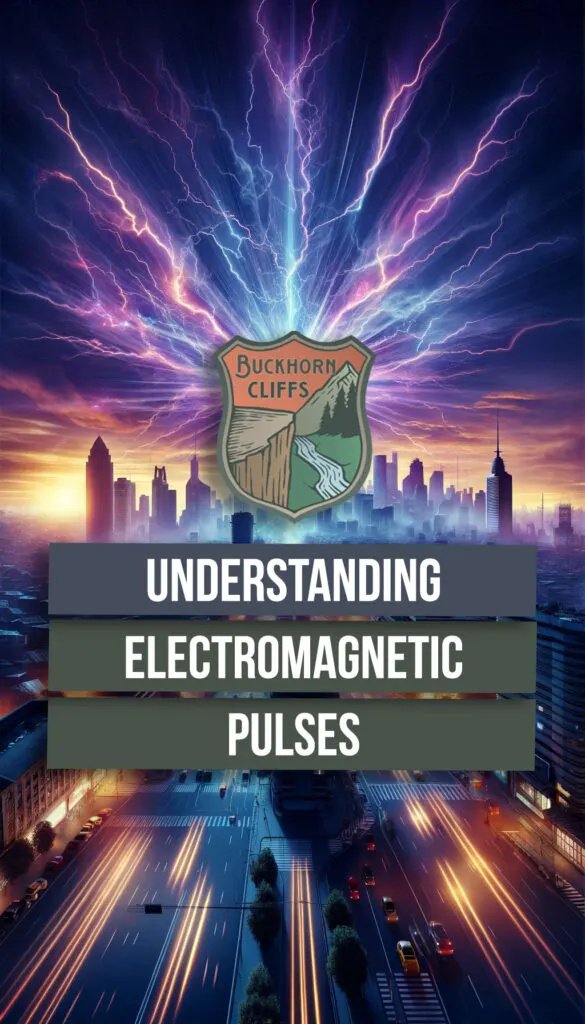In the modern age, where technology drives everything from daily communications to military operations, few things are as potentially disruptive as an Electromagnetic Pulse (EMP). But what exactly is an EMP, and why should you be concerned about it? This article aims to break down the various sources of EMPs and delve deep into the implications of using such a pulse, particularly in a war setting.
Nuclear Electromagnetic Pulse (NEMP)
A Nuclear Electromagnetic Pulse, or NEMP, is one of the most widely known sources of EMP. It results from high-altitude nuclear explosions. When a nuclear explosion occurs in the atmosphere, it releases a burst of gamma rays. These gamma rays then collide with air molecules, creating a wave of electrically charged particles that can spread out and create an electromagnetic pulse on the ground.
Effects: The pulse created by a NEMP can cover a vast area, potentially even an entire continent if detonated at a high enough altitude. Such a wide-reaching pulse can disable electronic equipment, destroy power grids, and even cause long-term damage to infrastructures.
Non-Nuclear Electromagnetic Pulse Weapons (NNEMP)
Unlike NEMP, Non-Nuclear Electromagnetic Pulse Weapons do not rely on nuclear explosions. Instead, NNEMPs use conventional explosives combined with electrical devices to produce a localized EMP effect.
Effects: These pulses are far more localized than NEMPs. However, they can be just as effective within their limited range. Their primary advantage is their precision — they can target specific facilities or equipment without causing widespread collateral damage.
Solar-Generated EMPs
Nature has its way of reminding us of its power. One such method is through solar-generated EMPs. Large solar flares, or coronal mass ejections, can send out bursts of electromagnetic radiation towards Earth.
Effects: A significant enough solar flare can disrupt satellites, radio communications, and even power grids. Historically, the Carrington Event of 1859 is an example of a solar storm that caused widespread disruption.
The Grave Consequences of EMPs in War Settings
In a war setting, EMPs, regardless of their source, can have devastating effects. Here’s a closer look at the potential implications:
Disruption of Military Equipment
The military heavily relies on technology and electronic equipment. An EMP can immediately render these devices inoperable. This includes everything from communication devices to more complex systems like missile defense systems or aircraft.
Collapse of Communication Networks
Communication is a cornerstone of modern warfare. An EMP can cripple communication networks, leaving troops in the dark and leadership unable to command and control operations.
Infrastructure Breakdown
It’s not just military installations that are vulnerable. An EMP can disrupt civilian infrastructures like power grids, water supplies, and transportation systems. Such disruptions can lead to chaos, especially in urban centers.
Economic Consequences
The long-term damage to infrastructures can lead to severe economic repercussions. Stock markets can crash, trade can come to a standstill, and daily business operations can be disrupted.
Why should we be concerned about an enemy using EMP technology?
An enemy’s use of Electromagnetic Pulse (EMP) technology is deeply concerning for several reasons:
- Widespread Infrastructure Damage: EMPs can disrupt or permanently damage electrical and electronic systems. Critical infrastructure, such as power grids, water treatment facilities, and transportation systems, could be crippled for extended periods. Such disruptions would significantly impact a nation’s ability to function.
- Military Paralysis: Modern military operations are heavily reliant on sophisticated electronic equipment and communication systems. An EMP attack could render these systems inoperable, leaving forces blind, mute, and deaf on the battlefield. This would critically impede a nation’s defense capabilities, making it vulnerable to further attacks.
- Economic Consequences: The economic repercussions of a widespread EMP event could be catastrophic. With the power grid and electronic banking systems down, stock markets could crash, business operations could halt, and trade could be severely affected, plunging a nation into an economic crisis.
- Healthcare and Emergency Services Impact: Medical equipment, emergency communication systems, and tools essential for healthcare delivery could be rendered useless. This can result in loss of life, especially for those reliant on electronic medical devices or in critical care.
- Civil Unrest: The disruption of essential services, combined with limited access to information and dwindling resources, could lead to panic and civil unrest. This could exacerbate the situation, stretching emergency services thin and potentially leading to further loss of life and property.
- Long-term Recovery Challenges: Depending on the severity and extent of the EMP, recovery could take years. The interconnected nature of modern infrastructure means that damage to one system can cascade and affect multiple sectors.
- Cyber Vulnerability: Post an EMP attack, a nation’s cyber defenses might be compromised, making it susceptible to cyber-attacks, data breaches, and espionage.
- Strategic Advantage for the Attacker: By using EMPs, an enemy can gain a significant tactical and strategic advantage, disabling defenses and infrastructure without the direct use of force or large-scale physical destruction.
- Absence of Physical Warning: EMPs can be deployed without the visible theatrics of traditional warfare. There may be no immediate signs like inbound missiles, making it a stealthy and sudden form of attack.
- Difficulties in Attribution: Identifying the perpetrator of an EMP attack can be challenging, especially if it’s a high-altitude detonation. This can delay or complicate a targeted retaliatory response.
Does the United States government train or have protocols if this happens?
Yes, the United States government is aware of the potential threats posed by Electromagnetic Pulses (EMPs) and has taken measures to train for, mitigate, and respond to such events. The concern about EMPs, especially those resulting from high-altitude nuclear explosions, dates back to Cold War-era nuclear tests. Over the years, various initiatives, studies, and protocols have been developed to address the potential impacts of EMPs.
- Commission to Assess the Threat: The U.S. Congress established the “Commission to Assess the Threat to the United States from Electromagnetic Pulse (EMP) Attack” in 2001. The commission was tasked with assessing the nature and magnitude of potential EMP threats, the country’s vulnerability to these threats, and the capability to recover from an EMP event. The commission released reports highlighting vulnerabilities and made recommendations.
- Training and Exercises: Various branches of the U.S. military and government agencies conduct training and exercises to prepare for the possibility of an EMP event, ensuring continuity of operations and rapid response to such threats.
- Infrastructure Hardening: Efforts have been made to “harden” critical infrastructure against EMPs. Hardening can involve physically shielding equipment, using surge protectors, and establishing redundant systems.
- Executive Order: In 2019, then-President Donald Trump signed an executive order titled “Coordinating National Resilience to Electromagnetic Pulses,” which aimed to bolster national resilience to EMPs. The order directed federal agencies to identify critical infrastructure at risk, improve EMP resilience across the board, and promote R&D for EMP mitigation.
- Federal Plans and Protocols: Various federal agencies, such as the Department of Homeland Security (DHS) and the Federal Emergency Management Agency (FEMA), have protocols and plans in place for responding to and recovering from EMP events.
- Collaboration with Private Sector: The U.S. government works with the private sector, especially utility companies, to develop strategies and standards for EMP resilience, as a significant portion of the power grid is owned and operated by private entities.
- Research and Development: The U.S. has invested in research to better understand the effects of EMPs and develop mitigation strategies. Laboratories and defense agencies study potential EMP impacts on different systems and technologies.
- Public Awareness and Preparedness: While the primary focus is on protecting national security and critical infrastructure, there are also efforts to educate the public about EMPs and encourage personal preparedness.
What happens to everyday people if there’s an EMP on a large scale?
An Electromagnetic Pulse (EMP) on a large scale, especially if it affects a significant portion of a country or continent, would have profound and immediate consequences for everyday citizens. Here’s a breakdown of how life might change in the aftermath of a major EMP event:
- Loss of Power: The most immediate and noticeable effect would be the widespread loss of electricity. Power grids are particularly susceptible to EMPs, and a significant EMP event could plunge entire cities or regions into darkness, potentially for an extended period.
- Communication Breakdown: Many communication devices, including cell phones, radios, and internet routers, could be rendered inoperable. This would make it difficult for individuals to contact loved ones or receive updates on the situation.
- Transportation Disruptions: Modern vehicles rely on electronic components for their operation. An EMP could disable these components, rendering many cars, trucks, and buses inoperable. Public transportation systems, like subways or commuter trains, could also be affected.
- Banking and Commerce: ATMs and point-of-sale systems might fail, making it difficult to access money or conduct transactions. The disruption in electronic banking could lead to an immediate dependence on physical currency, barter, or other means of trade.
- Loss of Essential Services: Services that rely on electricity, like water purification and sewage treatment, could stop. This could lead to sanitation and public health concerns.
- Medical Concerns: Hospitals and medical facilities would be severely impacted, especially if backup power systems fail. Life-sustaining equipment might stop working, and essential medical supplies could run out.
- Food and Water Shortages: With transportation and communication disrupted, the supply chain for food and other essentials would be severely impacted. Stores could run out of supplies quickly, and without refrigeration, perishable goods would spoil. Access to clean water might also become a significant concern.
- Breakdown of Law and Order: As resources become scarce, and if the disruption continues for an extended period, there might be an increase in crime, looting, and civil unrest. Law enforcement agencies might be overwhelmed, and response times could increase.
- Dependency on Analog Technologies: People might need to revert to older, non-electronic methods for tasks like communication, navigation, and entertainment. Think of using maps instead of GPS or reading physical books instead of e-readers.
- Psychological Impact: The sudden and profound shift in daily life, coupled with uncertainty about the future, could have significant psychological impacts on many individuals, leading to stress, anxiety, and other mental health challenges.
- Community Reliance: On the positive side, such events often see communities coming together. Neighbors might pool resources, share food, or take turns keeping watch. The inherent need for community and collaboration could become even more pronounced in these challenging times.

